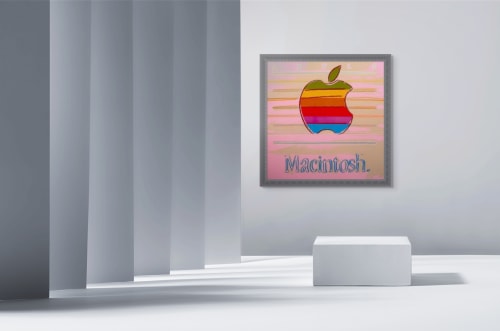Warhol’s influence undeniably extends far beyond the vivid pop art canvases and prints for which he is most famous. As a visionary artist and cultural icon, he predicted and shaped the merging of art with technology, a trend that continues to influence the contemporary art world. His works, known for embracing popular culture and mass production, challenged conventional ideas of what art could be.
Warhol’s foresight into technology's role in art can be seen in creations like the Andy Warhol Robot, the use of AI to recreate his voice in The Andy Warhol Diaries, and his connection to Apple. These efforts positioned him not only as an artist but as a trailblazer in the digital revolution of art. Warhol’s iconic studio, The Factory, was a key player in revolutionizing art production, transforming it into a process resembling industrial manufacturing, and challenging traditional concepts of artistry and authorship. Situated in a series of lofts in New York, The Factory was more than a workspace—it reimagined the entire concept of art creation. Its name itself signified its role as a hub of mass art production, mirroring the industrial factory model.
Warhol's use of silk-screening allowed him to produce large quantities of his famous works like Campbell’s Soup Cans and Marilyn Monroe portraits, drawing a parallel to industrial manufacturing where repetition and volume are key.
In 1981, Warhol collaborated with engineers and robotics experts to create a mechanical version of himself—the Andy Warhol Robot. This creation was part of his ongoing exploration of technology’s potential in the art world, highlighting his continual efforts to redefine artistic expression. The robot was designed to be a technological self-portrait, emulating Warhol's appearance and mannerisms while extending his artistic persona. His interest in this robotic creation further illustrated his lifelong obsession with replication and mass production, themes central to his art. The robot embodied Warhol’s desire not just to replicate images, but his very identity.
Unlike traditional self-portraits, which capture the artist’s physical or emotional state, Warhol’s robot reimagined the genre entirely. It was a self-portrait capable of interaction with the world, blurring the lines between the artist and their creation, as well as between art and life. The robot stood as a testament to Warhol’s avant-garde approach, showing his openness to embracing new technologies and his foresight into the role of automation and AI in society. It also served as a commentary on the mechanization of human existence.
Though the robot was never fully completed or publicly exhibited, its conceptual significance remains profound. It raised questions about authenticity and originality—central themes in Warhol’s body of work—and explored the intersection of human creativity and technological innovation. The Andy Warhol Robot can be seen as a precursor to today’s AI and robotic art explorations, setting the stage for future generations of artists to push the boundaries of machines in art creation. As a technological self-portrait, it encapsulated Warhol’s innovative spirit and his insightful commentary on his society—commentary that still resonates in today’s digital age.
In the mid-1980s, Warhol began to embrace the emerging technology of computers. In 1984, Apple co-founder Steve Jobs introduced Warhol to a Macintosh computer at Sean Lennon’s 9th birthday party. This introduction came in the same year Apple launched the first Macintosh to the public, with a groundbreaking commercial directed by Ridley Scott. At the time, Apple’s ad campaign was a major cultural moment, making Warhol’s connection with the brand feel both timely and prophetic.
The endorsement of Warhol’s technological ventures by the Andy Warhol Estate further strengthens his legacy as a pioneer in merging art with technology. This support reflects a deep appreciation for his artistic vision and an acknowledgment of his fascination with the replication and mechanization of human identity. Warhol’s iconic phrase, "fifteen minutes of fame," has gained new relevance in the era of social media and instant fame, underscoring his sharp insight into the fleeting nature of celebrity—a concept that defines the digital era.
Furthermore, Warhol’s artistic methods, particularly his approach to mass-producing art at The Factory, foreshadowed ongoing discussions about the democratization of art and the changing role of the artist in society. His work blurred the lines between art and commerce, creator and creation, sparking continued debates on the nature of authenticity in art. Warhol’s exploration of art and technology was not just a temporary phase or a series of experiments, but rather a profound reflection on the evolving relationship between human creativity and technological progress. Warhol’s legacy, therefore, is not limited to his iconic artworks but is also ingrained in his ability to predict and shape future dialogues between art, technology, and culture. His influence endures, inspiring new generations of artists and thinkers to explore and redefine the limits of creative expression in the digital age.
For more information on our andy warhol prints for sale and to buy original andy warhol art, contact info@guyhepner.com for our latest availabilities. Looking to sell? we can help. speak to our team to sell your warhol print.

